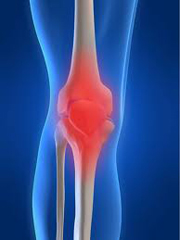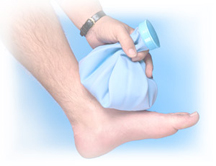Total Therapy Blog
Gearing Up for the Run… Injury Treatment
 Welcome to our fifth part of “Gearing Up for the Run”. We are excited for the upcoming Vancouver Sun Run and hope you are too! Last article, we talked about injury prevention while running. But what if we do get injured? This week we will discuss general guidelines to help you deal with a running injury. If you have missed our previous 3 articles, you can find them here: Part 1, Part 2, Part 3, Part 4.
Welcome to our fifth part of “Gearing Up for the Run”. We are excited for the upcoming Vancouver Sun Run and hope you are too! Last article, we talked about injury prevention while running. But what if we do get injured? This week we will discuss general guidelines to help you deal with a running injury. If you have missed our previous 3 articles, you can find them here: Part 1, Part 2, Part 3, Part 4.
What to do when you’re injured
In our previous articles, we talked about how to prevent injuries. Sometimes, though, injuries happen – despite our best intentions. Each injury (just like the individual) is unique, so the approach you take to treat an injury will vary. Here, we’ll aim to provide you with a few general guidelines to help you deal with a running injury.
The Acute Phase – Diagnosis
 You’ve just injured yourself. This is the point where the injury is “fresh” – depending on what you’ve done, you may experience swelling, bruising, redness, tenderness, etc around the affected area.
You’ve just injured yourself. This is the point where the injury is “fresh” – depending on what you’ve done, you may experience swelling, bruising, redness, tenderness, etc around the affected area.
The first step is to get a diagnosis as to what’s wrong. Depending on the severity, time-of-day, and your location, this may involve a trip to the emergency room, an appointment with your family doctor, or a visit to your physiotherapist. (Good rule-of-thumb: if you can’t walk, are experiencing unusual pain or numbness/tingling, see someone right away. If you’re not sure if it’s urgent, call the BC Nurses’ Hotline at 8-1-1 to get advice). Armed with a proper diagnosis, you can move on to the treatment phase.
The Acute Phase – Early Healing
The nature of your injury will determine the treatment protocol you follow – if what you’re told by your physiotherapist or doctor differs from this section, follow their advice. In general, though, the early stages of treatment follow the RICE principles – active Rest, Ice, Compression, and Elevation.
Active Rest – current research supports an active rest approach, meaning that you protect the injured area, but you permit movement in a controlled, pain-free range (sport injuries). The reasoning behind this is that movement promotes circulation, encourages proper scar formation, and reduces swelling. There are exceptions, of course, so follow your physiotherapist or doctor’s advice.

Ice – this is a controversial topic. Recent studies into icing suggest that too much icing actually hinders healing (Icing could slow injuries). For this, it’s best to take a “Goldilocks” approach – not too much, not too little. Try icing for 10 minutes, then taking the ice off until the area is warm to the touch again.
Compression – this is designed to keep the swelling down, but just like with icing, there is such thing as too much of a good thing. If you are wrapping an area, ensure that it doesn’t lose feeling and go numb on you. Also, avoid wearing a wrap to bed unless specifically told to do so by your physiotherapist or doctor. Finally, throughout the day take the wrapping off periodically to allow some circulation to flow to the affected area. Remember – your body needs circulation to heal. Shutting that off completely causes more harm than good.
Elevation – position the affected area above the level of chest. This encourages the return of lymph (fluid found in your tissue) and blood back to the heart, decreasing swelling. Like with all things, it’s best to take a moderation approach to this – if you feel like your foot is losing feeling, lower it back down to chest level to restore circulation.
The Rehab Phase
 This phase varies significantly with the individual and the injury. The most important thing about rehab is that you do it. Passively receiving treatment from your therapist will only take you so far. It is up to you to put the work into your rehab and ask questions about what you don’t understand.
This phase varies significantly with the individual and the injury. The most important thing about rehab is that you do it. Passively receiving treatment from your therapist will only take you so far. It is up to you to put the work into your rehab and ask questions about what you don’t understand.
Here are some of the classic mistakes people make:
Trying too much
Follow the treatment plan established between you and your physiotherapist, doctor, or other healthcare professional. Don’t rush into things until you’ve gotten the go-ahead from your therapist. Skipping steps in the process can push you back, costing you time.
Trying too little
Some people run into the opposite problem – they become very protective of the injured area, and are reluctant to do anything because they’re concerned about reinjury. Talk to your therapist – they will work with you to set-up an individualized program that is safe and effective.
Losing interest/falling off the wagon
We’ve all done it – you start out doing your rehab every day. Then life happens, you get busy, and you stop following the plan. This is a tough problem to solve. Think of your rehab like your bank account – when you’re injured, you’ve overdrawn your account and are “in the red”. Every day you stick to your rehab plan, you put a little bit more money back in the bank. If you stop following the plan, you stop depositing money in the bank, and you don’t progress further.
Skipping the final stages of rehab
You’ve finished with the beginner stuff, and you’re feeling good. You’re no longer having difficulty doing most activities. However, you’re not quite done yet – you need to finish off your rehab. This is the easiest part to forget, because you feel good. Again, stick to the plan – the whole plan – and you’ll be successful.
This article gives you an overview of what to do when you’re injured. The most important thing about treating an injury is to recognize when it happens and get help. Don’t try to solve things on your own! See your family doctor, physiotherapist, or other healthcare professional so you can get started on a rehab plan that will work for you. Good luck!
Have you gone through any training injuries? What was your injury and how did you treat it? Please share with us in the comment section below.
We have just updated our comment section so it is easier for everyone to post comments. Registration is not required anymore, only your name and email (which will not be shared) will be needed!








Follow Us!
& Stay Up To Date
BLOG